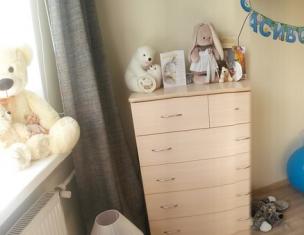XS (S, M, L, 1X, 2X, 3X)
Bust: 85 (95, 105, 115, 125, 135, 145) cm
Product length: 60 (60, 63, 64, 65, 66, 68) cm
Materials (edit)
Berroco Elements yarn (51% wool, 49% nylon, 140 m / 50 g) 6 (6, 7, 8, 9, 10, 11) skeins. 4 and 5 mm needles
Knitting density
18 sts x 25 p = 10x10 cm front surface, needles 5 mm
28 sts x 32 p = 10x10 cm elastic band 2x2, needles 4 mm
Description
Pattern: the number of loops is a multiple of 4 + 2.
1 row: out. NS.
2nd row: persons. NS.
3rd row: 2 persons. n., * 2 life. n., 2 persons. p. *, repeat to the end of the row
4 row: 2 out. n., * 2 persons. n., 2 out. p. *, repeat to the end of the row
Back
On 4 mm needles, cast on 118 (134, 146, 162, 174, 190, 202) sts. Starting with knit 2 knit, knit 8 cm with a 2x2 elastic band. Go to 5mm needles. In the next row, evenly subtract 40 (48, 52, 56, 60, 68, 72) sts. Then knit with a pattern to a height of 38 (38, 39, 39, 40, 40, 40) cm from the typesetting edge. To form the armhole of the sleeves, subtract 5 (5, 6, 6, 7, 7, 8) sts from 2 sides in the next 2 rows and another 2 sts in the next two rows - 64 (72, 78, 90 , 96, 104, 110) p. Next, make the deductions as follows:
Persons. p .: 1 person. p., 2 p. together, knit to the last 3 p. - remove 1 p. as knit on the right knitting needle, remove one as knit on the right knitting needle, thread the left knitting needle into the two that have been removed and remove them, knit both loops together as knitted for back arches of loops, 1 person. p. Purl row knit according to the pattern. Repeat these 2 rows 4 (7, 6, 10, 11, 13, 13) times - 54 (56, 64, 68, 72, 76, 82) sts. Knit armhole to 19 (19, 20, 21, 21, 22, 24) cm.To form shoulder slopes, close on both sides first 2 (2, 3, 4, 5, 5, 6) sts in the next 4 rows, then 1 (2, 4, 4, 4, 6 , 7) sts in the next 2 rows. Move the remaining 44 p. To add. knitting needle.
Front
Knit in the same way as the back. When the armhole height of the sleeves is 10 cm, start knitting the neckline as follows: on the left side, knit 14 (16, 18, 20, 22, 24, 26) sts (transfer the remaining loops to the additional knitting needle) until the armhole height of the sleeve is length 16 (16, 17, 18, 18.20, 21) cm.In the next row, close 5 sts for the neckline, then close 1 st 4 times, there will be 5 (7, 10, 12, 14, 16, 19 ) p. Tie to the armhole height of the sleeves 19 (19, 20, 21, 21, 22, 24) cm.For the shoulder slope, close 2 times 2 (2, 3, 4, 5, 5, 6) p. close the remaining 1 (2, 4, 4, 4, 6, 7) p.
For the right side, transfer 40 (40, 46, 48, 50, 52, 54) sts to the working needles (5 mm) and close 31 sts in the first row, knit the row to the end. In the next row for the neckline, close 4x1 p. 5 (7, 10, 12, 14, 16, 19) p. Tie 19 (19, 20, 21, 21, 22, 24) cm to the armhole height and for the shoulder slope close 2 times in 2 (2, 3, 4, 5, 5, 6) sts and in the next row close the remaining 1 (2, 4, 4, 4, 6, 7) sts.
Sleeves
On knitting needles 4 mm, dial 70 stitches, knit with a 2x2 elastic band to a height of 8 cm.Go to 5mm knitting needles and in the next purl row, evenly decrease 24 stitches.Knit with a pattern of 3 cm and then every 5 (3, 2.5, 2, 1, 1 , 1) cm, make increments on both sides 3 (5, 7, 10, 12, 14, 16) times, tying the loops from the broach of the lower row. On the needles 54 (58, 62, 68, 72, 76, 80) sts. When the sleeve length is 30 cm for an okat on both sides in the next 2 rows, close 5 (5, 6, 6, 7, 7, 8) p. and another 2 p. in the next 2 rows. Then close 1 p. In each 4th row 2 (0, 1, 0, 0, 0, 0) times, then in each row 1 p. 10 (14, 12, 15, 15, 17, 17) once. In the next 2 rows, close 2 (2, 2, 3, 4, 4, 3) sts on both sides. Transfer the remaining 12 (12, 16, 16, 16, 16, 20) sts to additional sts. knitting needle.
Assembly
Sew the front and back, complete all seams and sew on the sleeves. For the neck on the 4 mm knitting needles, dial 136 sts, knit 1 row out. etc. and in the next row close all the loops.
A dress of a form-fitting silhouette, with three-quarter sleeves, knitted with a semi-patent elastic band in three strands, will be your favorite.
Dimensions: 36/38 (40/42-44/46).
You will need: yarn (70% mohair wool, 30% silk; 210 m / 25 g) - 325 (325-350) g dark turquoise; yarn (80% sheep wool, 10% cashmere wool, 10% polyamide; 320 m / 50 g) - 250 (250-300) g gray-blue; knitting needles number 6; circular needles No. 6, 40 cm long; hook number 4.
PATTERNS
Semi-patent rubber band:
rows in forward and backward directions, odd number of loops.
1st row(= purl row): chrome, 1 p. remove with 1 crochet, as with purl knitting, * 1 person., remove the next loop with 1 crochet, as with purl, from * repeat, chrome.
2nd row(= front row): chrome, crochet and the removed loop of the previous row, knit together the front, * 1 out., the crochet and the removed loop of the previous row, knit together the front, from * repeat, chrome.
in circular rows, an even number of loops.
1st circle.r .:* 1 p. With 1 crochet, remove, as with purl knitting, 1 out., From * repeat.
2nd circle.r .:* yarn over and the removed loop of the previous row, knit together the front, 1 out., from * repeat.
Knitting density: 15 p.x 30 p. circle r. = 10 x 10 cm - semi-patent elastic band.
The sample is made with a triple thread, measured in a slightly stretched form.
Attention: knit dress with triple thread (= 1 dark turquoise thread and 2 gray-blue threads).
 Back: with triple thread, dial 73 (81-89) sts and knit with a semi-patent elastic band in rows in the forward and backward direction. Through 38 cm = 115 p. from the dial-up row, subtract on both sides for side bevels 1 time by 1 p., then in each 6th p. 8 times 1 p. = 55 (63-71) p. Then knit in a straight line. Through 7 cm = 22 p. from the last decrease, add 1 p. on both sides for side bevels, then 3 times on both sides, 1 p. in each 4th p. and 2 times 1 p. in each 6th p. = 67 (75-83) p. After 16 cm = 48 p. from the last increase (= after 85 cm = 257 p. from the typesetting row) close on both sides for armholes 1 time for 3 p., then in each 2nd p. 1 time in 2 p. And 2 (3-4) times in 1 p. = 53 (59-65) p. After 22 (22.5-23) cm = 66 (68-70) p. from the beginning of the armholes close on both sides for shoulder bevels 1 time for 6 (7-9) p., Then in every 2nd p. 1 time in 6 (8-9) sts. Simultaneously with the 1st decrease for the shoulder bevels, close the middle 27 sts for the neckline and finish first left side... Close from the inner edge to round off the neck in the next 2nd p. 1 more time 1 p. Finish the other side symmetrically.
Back: with triple thread, dial 73 (81-89) sts and knit with a semi-patent elastic band in rows in the forward and backward direction. Through 38 cm = 115 p. from the dial-up row, subtract on both sides for side bevels 1 time by 1 p., then in each 6th p. 8 times 1 p. = 55 (63-71) p. Then knit in a straight line. Through 7 cm = 22 p. from the last decrease, add 1 p. on both sides for side bevels, then 3 times on both sides, 1 p. in each 4th p. and 2 times 1 p. in each 6th p. = 67 (75-83) p. After 16 cm = 48 p. from the last increase (= after 85 cm = 257 p. from the typesetting row) close on both sides for armholes 1 time for 3 p., then in each 2nd p. 1 time in 2 p. And 2 (3-4) times in 1 p. = 53 (59-65) p. After 22 (22.5-23) cm = 66 (68-70) p. from the beginning of the armholes close on both sides for shoulder bevels 1 time for 6 (7-9) p., Then in every 2nd p. 1 time in 6 (8-9) sts. Simultaneously with the 1st decrease for the shoulder bevels, close the middle 27 sts for the neckline and finish first left side... Close from the inner edge to round off the neck in the next 2nd p. 1 more time 1 p. Finish the other side symmetrically.
Front: knit like a back, but for a deeper neck, close the middle 9 sts after 15.5 (16-16.5) cm = 46 (48-50) p. from the beginning of the armholes and finish the left side first. To round the neck, close from the inner edge 1 time 3 p., 1 time 2 p., 3 times 1 p. In each 2nd p. and 2 times 1 p. in each 4th p.
Sleeves: with triple thread, dial 39 (43-47) sts and knit in rows in the forward and backward directions with a semi-patent elastic band. Through 4 cm = 11 p. from the typesetting row, add on both sides for bevels 1 time for 1 point, then 3 times for 1 point in each 10th p. = 47 (51-55) p. After 28 cm = 83 p. from the dial-up row, close on both sides for armholes 1 time in 2 p., then close for an okat in each 4th p. 9 times 1 p. And in every 2nd p. 1 (2-3) times 1 p. And 2 times 2 p. After 15 (15.5-16) cm = 44 (46-48) p. from the beginning of the formation of the okat, close the remaining 15 (17-19) p.
Novice knitters are often afraid to grab the sleeves. In fact, there is nothing impossible in this. This article shows several simple ways to knit your own sleeves using knitting needles.
Let's start with the easiest way to knit a sleeve, which is very convenient for children's models. These sleeves can always be knitted to the desired length. An approximate pattern is given in this photo:
The photo shows that the back and the shelf are knitted like a simple rectangle, without knitting the armhole. After connecting the shoulder seams, we collect loops directly from edge loops along the line of the armhole: half the width of the sleeve along the shelf, half along the back. It should be borne in mind that when recruiting loops from each edge, two loops are typed, one for the front wall, the other for the back. If the pattern is very voluminous, then you can alternate the set: from one edge two loops, from the other one. Then the armhole will neither gather nor stretch.
Well, if you are fiddling with sleeves, there is no desire, and please yourself with a light and warm product.
Learning the correct calculation of rows for decreasing
The number of rows for decreasing the sleeve width can be calculated according to the finished shelf or back. Place the pattern on a shelf or back in your mind. The cuffs of the sleeves will be on the elastic of the main part. Use a ruler to measure the required sleeve length and half of its width. Now connect the intersection of these lines to the beginning of the cuff. It will be immediately visible through how many rows you need to decrease the loops.
Exactly the same calculation will be for knitting from the bottom, from the cuff. Only the loops will need to be recruited, not subtracted. To avoid holes, it is better to knit an additional loop from the loop of the previous row, and not with a crochet.
We knit sleeves using raglan needles
It's pretty easy to knit a raglan sleeve over the top. This method allows you to try on the product as it is knitted: the place of the armpits, the length of the sleeve, the length of the product. The picture below shows an approximate diagram of a product with a raglan sleeve:

Using the pattern sample, calculate the number of loops required for the neckline. If there are no fasteners, then knitting can be started on sock knitting needles. As the number of loops increases, switch to circular. If the model has a fastener, then you can knit on straight knitting needles.
Divide the number of loops by 4, the raglan line will run along these loops. If the knitting of the sleeves is on straight knitting needles, then divide one of the parts in half under the fastener.

Mark the loops of the raglan lines with colored thread or pins so as not to skip them at the beginning of the work. This photo shows very clearly how to knit sleeves with knitting needles from above:

If the knitting is round, then additions are made in each odd row. If knitting is carried out on straight knitting needles, then make the addition in the front rows, knit the purl rows according to the pattern.
If you want the raglan line to be clearly visible, then always knit the marked loops with the front one, and make additions before and after them, as shown in the photo:

The addition of loops can be done both with a crochet and by knitting two loops from one. The crochets give holes in the pattern, while the knitted loops preserve an even, smooth fabric. Depending on the selected pattern, you can choose one or another method of adding loops.
In this way, knit up to the level of the armpits. Next, the loops of the sleeves are removed on extra knitting needles or pins. Continue knitting the main raglan sleeve pieces to the desired length.
Such sleeves are used when, because it is a complex and painstaking technique.
Seamless knitting and unrolled fabric
You can continue making the sleeve in two ways: with a seamless and expanded fabric, which is then sewn together.
For seamless knitting, removed sleeve stitches are piled on sock knitting needles or circulars. Mark the buttonhole that will guide the place to decrease the width of the sleeve. Regardless of the pattern, the thickness of the yarn and knitting needles, the size of the product, there is a general rule for decreasing (adding) the width of the sleeve.
For hands of normal thickness and length, the decrease (addition) of the loops is done in every 6th row. If the arms are full and short, in every 4th row. With thin and long arms decrease (addition) of loops is done in every 6-8 row. In children's models, upon reaching the required length of the sleeve, the excess width can simply be collected before tying the cuff by decreasing the loops 2-3 together in the last row. Count how many stitches you need for the cuff and how many are left in the row in front of the cuff. Determine the difference in the loops and distribute it evenly along the row, calculating how many loops you will need to make decreases.
Trying to hide the raglan line with our own hands
If you want to know how to hide the raglan line, then we answer - the addition of loops in the first row is done by knitting three from the marked loop: front, yarn, front. The next row is knitted according to the pattern. In the third row, the addition of loops is made from a knitted yarn also: front, yarn, front. Thus, the raglan line will always go along the knitted yarn. The photo below clearly shows that the place where the loops were added is almost invisible.

This original way allows you to create the appearance of the integrity of the canvas, it is more suitable for openwork patterns, with a large number of yarns. This will hide the raglan line.
This type of sleeve is ideal for underwear that even a beginner can knit.
Schemes describing the creation of a curly armhole
And, finally, it was the turn of the description of how to correctly knit a sleeve with a curly armhole. Since the article is designed for beginner knitters, for the first products, I would advise you to choose models from magazines with detailed description knitting sequences of parts. After you understand the principle of knitting various lines, you can start creating your own models.
The good thing about DIY things is their originality. Therefore, each model has its own sleeve shape and the calculation of additions-subtractions is also its own. But nevertheless, I will give several ways to knit an okata set-in sleeve.
As in the previous methods, set-in sleeve you can start at the top and bottom. One of the ways to knit an okat from below is shown in the figure below:

- The principle of expanding the sleeves remained the same as in previous methods of knitting sleeves with knitting needles.
- The numbers on the side of the sleeve show how many loops need to be reduced in each row.
- In the first row of the okat we immediately close (do not knit together!) 4 loops. We knit a row to the end.
- We turn on seamy side and here we close the same 4 loops.
- In the next row, we already knit 3 loops together on each side.
- And so on according to the knitting pattern.
- The designation 1x18 means that in the next 18 rows you need to subtract 1 loop.
- In the last, top row, close the remaining several loops at once.
Knitting the original model without using a pattern
If you decide to knit your model without a pattern, then this method of knitting an okata set-in sleeve may be suitable.
- In the first row of the okat we close 3 loops each.
- We do all the reductions in the front rows.
- In the 3rd and 5th rows, we subtract 2 loops from each edge, i.e. knit 3 loops together.
- In the next 12 front rows, we subtract 1 loop (knit 2 together).
- Then 2 times in 2 loops (3 together), once in 3, once 4 loops.
- We close the remaining loops in one row.
Product creation in short rows quickly and easily
If you know how to knit in shortened rows, then you can use the following method for knitting an okat sleeve.
- In the first row, close the same 3-4 loops.
- And do not complete each front row as many loops as indicated in the previous method.
- Those. without tying the required number of loops to the end of the row, turn the work and go back.
- It is better to write down the scheme of decreasing, so as not to calculate again in the second sleeve.
- If you have enough thread, it is better to run both sleeves in parallel at once.
It is a little more difficult to knit such a sleeve from above, but you do not have to sew it in. Therefore, it is better to watch the master class in the video below.
If you still have not mastered the technique of knitting sleeves, try to knit with your own hands.
Video for Beginner Masters
We hope that things connected by yourself will delight you and your loved ones for a long time.
Comments (1) on How to knit a sleeve without a pattern disabledIt so happens that we knit a model, the description of knitting of which we do not have. And we often face the fact that we have problems with how to knit a sleeve, how to correctly calculate the loops for expanding the sleeve and forming its okat. In this article, I will tell you how to knit sleeves shape narrowed to the wrist, how to calculate the number of added loops needed to expand the sleeves up without a pattern, as well as how to knit a sleeve with knitting needles using a method of decreasing loops, which is suitable for knitting with any knitting needles and yarn, regardless of knitting density.
Sleeves can be knitted in several ways - from bottom to top, from the beginning of the sleeve to the top point of the ridge, from top to bottom, from the top point of the sleeve to its bottom, as well as cross-knit - from one side seam to the other. Now we will figure out how to knit a sleeve with knitting needles from the bottom up.
How to knit a sleeve from the beginning to the okat line:
1. The first thing, before we start knitting the sleeve with knitting needles, are three basic measurements: sleeve length from the beginning of the sleeve to the okat line (to the armpit), the width of the sleeve in the lower, narrowest part and the width of the sleeve in the upper, widest part. If the sleeve starts from the cuff or cuff, measure the sleeve length from the end of the cuff.
2. Determine the number of stitches corresponding to the measurements of the width of the sleeve in the narrow and wide part. Next, count the number of rows that correspond to the length of the sleeve. You can read how to do this here.
3. Now we determine the number of loops that need to be added to expand the sleeve. To do this, subtract the number of loops in the narrowest part from the number of loops in the widest part. Since we will add loops on both sides of the sleeve, the resulting number must be divided by two.
4. To determine how many rows you need to add loops, divide the number of rows corresponding to the sleeve length by the number obtained above. The resulting value corresponds to the number of rows through which you need to add loops.
Example:
the width of the sleeve at the bottom is 20 cm, which is 40 loops, the width at the top is 36 cm = 72 loops, the length of the sleeve is 50 cm = 130 rows.
Let's count: (72 loops - 40 loops): 2 = 16
130 rows: 16 = 8.125, round up to 8. This value shows that the additions must be added in each 8th row, 1 loop from the left and right edges of the sleeve.
If you get an odd number, for example 7, then this means that the additions need to be done alternately: in the 6th and then in the 8th rows.
there is the following pattern in the addition of loops when knitting narrow sleeves - if the arms are long and thin, then the additions are made in every 6 - 8 row, for hands of normal length and fullness - in every 6th row, and if the arms are full and short, then in every 4.
How best to make additions.
The most optimal way to add loops for expanding the sleeve is as follows: at the beginning of the row in which you need to make additions, remove the hem, knit the yarn with a movement towards you, after which we knit a row, and before the hem we knit another yarn.
In the next seamy row, these yarns should be knit with front loops behind the back wall.
How to knit okat sleeves:
I hope that now you will not have any problems with how to knit sleeves without a pattern. Well, if something turned out to be incomprehensible, contact us - we'll figure it out together!
Chest circumference ( ready product): 80 (90-100-110-120-130) cm
Length: 59 (61-64-66-69-71) cm
Materials (edit)
Yarn BERROCO ULTRA ALPACA LIGHT (50% alpaca, 50% wool, 50 g / 133 m) 7 (8-9-10-11-13) skeins of blue color, circular needles 3.5 mm and 4 mm
Knitting density
22 p. And 28 p. = 10x10 cm face stitch on needles 4 mm
Description
Back pattern
1 row: 2 p., 1 p., 2 p., 2 p., 1 p., 1 l., Yarn, broach (remove 1 p. As persons. , 1 persons.p. and stretch it through the removed one), 1 persons.p., 2 persons.p., 2 persons.p., 1 persons.p., 2 persons.p., 2 persons.p., 2 outn. = 23 p.
2 row: 2 persons.p., 2 persons.p., 2 persons.p., 1 N.p., 2 persons.p., 2 N.p., 1 persons.p., 1 N.p. , yarn, 2 sts together, 1 person, 2, 2, 2, 1, 2 = 23 p.
3 row: 2 out of item, knit a trace. persons.p. for the front and back walls, 2 persons, 2 persons, 1, 1, y, yarn, broach, 1, 2, 2 ., knit a trace. persons.p. for the front and back walls, 2 N.p., 2 persons.p., 2 N.p. = 25 p.
4 row: 2 persons.p., 2 persons.p., 2 persons.p., 2 sts. Together, 2 persons.p., 2 persons.p., 1 persons.p., 1 N.p. ., yarn, 2 p. together out., 1 person. p., 2 out., 2 person. p., 2 p. together out., 2 persons. = 23 p.
Repeat these 4 rows for the backrest.
Front pattern(start and end on 23 p.):
1 row: 2 persons.p., 2 persons.p., 2 persons.p., 1 persons.p., 2 persons.p., 2 persons.p., 1 persons.p., 1 persons. , yarn, broach, 1 N.p., 2 persons.p., 2 N.p., 1 person.p., 2 N.p. = 23 p.
2 row: 2 persons.p., 1 N.p., 2 persons.p., 2 N.p., 1 person.p., 1 N.p., yarn, 2 sts together out., 1 persons pp., 2 persons.p., 2 persons.p., 1 persons.p., 2 persons.p., 2 persons.p., 2 persons. = 23 p.
3 row: 2 out of item, 2 face of item, 2 out of item, knit next. persons.p. for the front and back walls, 2 persons, 2 persons, 1, 1, y, yarn, broach, 1, 2, 2 ., knit a trace. persons.p. for the front and back walls, 2 N.p. = 25 p.
4 row: 2 persons.p., 2 sts. Together out., 2 persons.p., 2 out., 1 person.p., 1 out., Yarn, 2 sts. Together out., 1 persons.p., 2 persons.p., 2 persons.p., 2 points together, 2 persons.p., 2 persons.p., 2 persons.p. = 23 p.
Repeat these 4 rows for the front.
Sleeve Pattern(start and end on 19 p.):
1 row: 2 pp., 1 persons., 2 pp., 2 persons., 1 pp., 1 persons., Yarn, broach, 1 pp., 2 persons.p., 2 n.p., 1 person.p., 2 n.p. = 19 p.
2 row: 2 persons.p., 1 N.p., 2 persons.p., 2 N.p., 1 person.p., 1 N.p., yarn, 2 sts together out., 1 persons pp., 2 persons.p., 2 persons.p., 1 pp., 2 persons. = 19 p.
3 row: 2 out of item, knit a trace. persons.p. for the front and back walls, 2 persons, 2 persons, 1, 1, y, yarn, broach, 1, 2, 2 ., knit a trace. persons.p. for the front and back walls, 2 N.p. = 21 p.
4 row: 2 persons.p., 2 sts. Together out., 2 persons.p., 2 out., 1 person.p., 1 out., Yarn, 2 sts. Together out., 1 persons.p., 2 persons.p., 2 persons.p., 2 points together, 2 persons.p. = 19 p.
Repeat these 4 rows for sleeves.
Back
On the 3.5 mm needles, cast on 110 (122-134-146-158-170) sts and knit with an elastic band 2x2 (2 persons, 2 out) 2.5 cm, end in faces. Switch to 4 mm needles and knit 1 row of outp, evenly decreasing 10 (10-12-12-14-14) sts = 100 (112-122-134-144-156) sts.
Track. row: 27 (33-38-44-49-55) persons, put a marker, knit 1 row with a 23 st pattern for the back, put a marker, knit persons. to the end of the row. Continue to work with a pattern and front satin stitch on the sides of the back to a height of 5 cm from the typesetting edge. In the next. persons, b. perform a number of decreases: 3 persons, 2 sts together, knit to the last. 5 loops of a row - broach, 3 persons. = 98 (110-120-132-142-154) sts. Repeat a series of decreases every 5 cm 5 more times = 88 (100-110-122-132-144) sts and knit the back to a height of 39 (40-4143- 44-45) cm, finish in I.R.
For the armholes of the sleeves at the beginning of the trail. 2 rows close 3 (3-3-4-5-5) sts, then 2 sts at the beginning of the next. 4 (6-8-8-8-10) p. = 74 (82-88-98-106-114) p. Next, perform a series of decreases in the next. persons, b. and then repeat it in each person. another 5 (6-7-9-10-11) times = 62 (68-72-78-84-90) p. At the height of the armholes of the sleeves 18 (19-20-21-23-24) cm, finish with the 4th next to the pattern for the back and mark the central 16 p.
For shoulder bevels, close 4 (4-5-6-6-6) sts at the beginning of the row, knit according to the pattern until there are 19 (22-23-25-28-31) sts on the right knitting needle, attach the thread from another skein and close the central 16 p. for the neckline, finish the row of faces. Next, knit both parts separately and at the beginning of the next. out. close 4 (4-5-6-6-6) sts. Then, for shoulder bevels, close 4 (4-5-6-6-6) sts at the beginning of the next. 1 (7-3-1-7-1) p., Then 3 (0-4-5-0-7) p. At the beginning of the next. 6 (0-4-6-0-6) p. At the same time, close 2 times 5 sts in the neckline on each side.
Front
Run an elastic band as for the back and knit from inside out, evenly decreasing the loops. Track. row: 50 (56-61-67-72-78) lts, put a marker, knit 1 row with a pattern for the front, put a marker, finish ls. Continue knitting to a height of 29 (31-34-36-39-41) cm from the typesetting edge, finish with the 2nd row of the pattern.
Track. row: knit persons. up to 6 loops in front of the first marker, put a marker, knit the first 6 loops according to the pattern, remove the marker, continue 1 row of the pattern to the last. marker, finish persons.
Knit 28 rows according to the pattern and finish in out r., At the same time, start forming the armholes of the sleeves as for the back.
To cut the neckline in the trail. persons, b. knit: continue forming the armholes of the sleeves as for the back, knit row 29 to the marker, attach the thread from another skein and finish the row according to the pattern.
Note: the loops in the neckline should be closed only in those rows where it is marked on the diagram, i.e. 46, 48, 50 and 52 p. After all the reductions in the armholes of the sleeves and in the neckline have been performed, 13 (16-18-21-24-27) sts will remain for the shoulder bevels. At the height of the armholes of the sleeves 18 (19-20-21-23-24) see to perform reductions as backrests.
Sleeves
On 3.5 mm knitting needles, cast on 54 sts and knit 2.5 cm with an elastic band, finish in faces. and switch to 4 mm needles, perform 1 row of outp, add 1 p. = 55 p.
Track. row: 18 lts, put a marker, knit 19 sts with a pattern for sleeves, put a marker, finish ls.
Knit according to the pattern to a height of 5 cm from the typesetting edge and in the next. in a row, make increases on both sides of the sleeve by tying a loop from the broach. Repeat a series of increments every 10 (4-2.5-2-2-1.5) cm another 2 (5-8-10-13-16) p. = 61 (67-73-77-83-89) p. At a height of 28 cm, close the sleeves for the okat at the beginning of the next. 2 rows 3 (3-3-4-5-5) sts, then 2 sts at the beginning of the next. 2 rows. Then make decreases of 1 p. On each side in each person. in the next. row and then another 12 (12-15-16-16-16) times = 25 (31-31-31-35-41) p. At the beginning of the next. 2 rows close 2 sts, then 3 sts at the beginning of the next. 2 rows. Close the remaining 15 (21-21-21-25-31) p.
Assembly
Execute shoulder seams... For collar with front side, starting from the division of the loops of the front, dial 158 p. In a circle, DO NOT connect, knit 1 row of faces.p, 1 row of out. and close all loops. Place the left side of the collar over the right side and sew.
Sew in sleeves, sew side seams and sleeve seams.
Translated with permission from Berroco, Inc.
Photos courtesy of Berroco, Inc.









